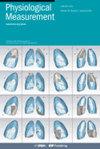用于电阻抗断层扫描图像重建的 TSS-ConvNet
IF 2.3
4区 医学
Q3 BIOPHYSICS
引用次数: 0
摘要
在本文中,我们提出了一种新颖的数据驱动方法,用于解决电阻抗断层扫描(EIT)等难以解决的逆问题。我们的方法引入了一种新的层架构,由三条路径组成:空间路径、光谱路径和截断光谱路径。空间路径在本地处理信息,而光谱路径和截断光谱路径则为网络提供全局感受野。这种结构有助于消除逆问题的不确定性和非线性。三条路径相互连接,允许在具有不同学习能力的不同感受野上交换信息。该网络具有瓶颈结构,能够从嘈杂的冗余测量中恢复信号信息。我们将所提出的模型称为截断空间-频谱卷积神经网络(TSSConvNet)。该模型克服了大多数现有模型仅使用欧几里得空间局部信息的感受野限制。我们在一个大型数据集上对该网络进行了训练,该数据集涵盖了各种随机参数的配置,以确保对训练样本的泛化。我们的模型在模拟和实验数据上都实现了较高的分辨率和卓越的准确性。本文章由计算机程序翻译,如有差异,请以英文原文为准。
TSS-ConvNet for electrical impedance tomography image reconstruction.
In this paper, we present a novel data-driven approach for solving ill-posed inverse problems, such as Electrical Impedance Tomography (EIT). Our approach introduces a new layer architecture composed of three paths: spatial, spectral, and truncated spectral paths. The spatial path processes information locally, while the spectral and truncated spectral paths provide the network with a global receptive field. Such architecture helps eliminate the ill-posedness and nonlinearity of the inverse problem. The three paths are interconnected, allowing for information exchange on different receptive fields with different learning abilities. The network has a bottleneck architecture which enables it to recover signal information from noisy redundant measurements. We call our proposed model Truncated Spatial-Spectral Convolutional neural Network (TSSConvNet). The model overcomes the receptive field limitation of the most existing models which use only the local information in Euclidean space. We trained the network on a large dataset that covers various configurations with random parameters to ensure generalization over the training samples. Our model achieves superior accuracy with relatively high resolution on both simulation and experimental data.
求助全文
通过发布文献求助,成功后即可免费获取论文全文。
去求助
来源期刊

Physiological measurement
生物-工程:生物医学
CiteScore
5.50
自引率
9.40%
发文量
124
审稿时长
3 months
期刊介绍:
Physiological Measurement publishes papers about the quantitative assessment and visualization of physiological function in clinical research and practice, with an emphasis on the development of new methods of measurement and their validation.
Papers are published on topics including:
applied physiology in illness and health
electrical bioimpedance, optical and acoustic measurement techniques
advanced methods of time series and other data analysis
biomedical and clinical engineering
in-patient and ambulatory monitoring
point-of-care technologies
novel clinical measurements of cardiovascular, neurological, and musculoskeletal systems.
measurements in molecular, cellular and organ physiology and electrophysiology
physiological modeling and simulation
novel biomedical sensors, instruments, devices and systems
measurement standards and guidelines.
 求助内容:
求助内容: 应助结果提醒方式:
应助结果提醒方式:


